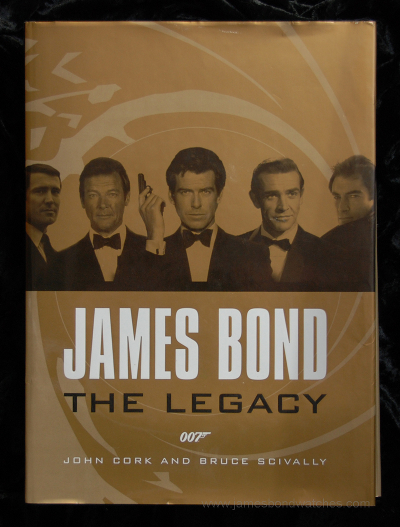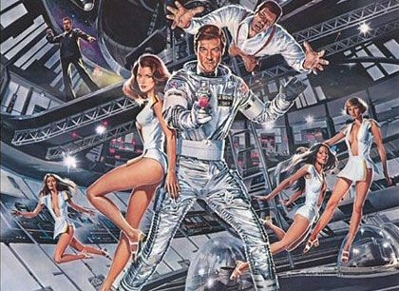|
James Bond: The Legacy

James Bond: The Legacy was written by John Cork and Bruce Scivally and
published in 2002. I have quite a few of these big illustrated coffee
table Bond books (if you wait until they are a few years old you can
often buy them for next to nothing) and this is one of the better ones.
There is always a feeling of deja vu with James Bond books but this one
at least attempts to be a bit different. The main focus here is on the
enduring appeal of the Bond series and how it has been gently modified
and tinkered with to reflect the times, but never too much because
there is a formula that made the Bond films popular and if you stray
too far people complain. This book only goes up to 2002 but the
terrible reviews Quantum of Solace received a few years ago for
eschewing the 007 staples and shamelessly trying to be Jason Bourne
tend to back up one of the main themes of James Bond: The Legacy.
Another thing about the book that was quite novel at the time is that
it includes the two 'unofficial' James Bond films Never Say Never Again
and 1967's Casino Royale, the two renegade pictures not made by EON
productions. Because MGM had recently acquired the rights to these
films at the time they were finally able to appear in a sanctioned Bond
book of this type alongside the 'official' entries.
The book says that James Bond films are set 'two minutes into the
future' and have both reflected trends and even been ahead of the game
in some areas, especially technology. Adjusted for inflation, the high
water mark for the series in terms of box-office was 1965's Thunderball
and the book suggests that this and 1964's Goldfinger marked the peak
of the Bondmania of the sixties and the series as a whole. With a
little help from things like Playboy Magazine and JFK naming From
Russia with Love as one of his favourite books, James Bond became a
huge cultural icon and was aided by the fact that it was practically
inventing a genre rather than competing against other action/adventure
films that were often just as good or better (as the series later had
to do). The book is quite interesting on how the series influenced a
whole slew of imitators but was later more than prepared to look around
at what was 'in' at the time and borrow here and there itself. Live and
Let Die riffed on the 'Blaxploitation' pictures while The Man with the
Golden Gun threw some kung fu into the mix. And of course, 1978's
Moonraker was a direct reaction to the huge success of Star Wars.

The focus on each particular Bond actor is interesting and there some
bits and pieces that will be new to most people. I quite enjoyed the
section about the origins of Bond's big screen debut and how Sean
Connery had to be scrubbed up and turned into the world's suavest and
most sophisticated secret agent. It was the Dr No director Terence
Young, a bit of a smoothie himself, who had to take Connery in hand and
make sure he looked the part. 'Terence Young provided the essentials
for Bond’s wardrobe. He took Sean Connery to famed shirt-maker Turnbull
& Asser for custom-designed shirts with turnback cuffs. Young had
his tailor Anthony Sinclair cut Connery’s suits. Sinclair’s suits,
which look traditional by today’s standards, were considered somewhat
rakish and fancy at the time. Bond needed to be well turned-out, a
fashion plate for the modern British man. Style was key to quickly
communicating the character of Bond. If he was to represent the best
the Western powers had to offer, he had to be surrounded by the best.
007 could not just drink vodka, it needed to be Smirnoff’s; he could
not just wear a watch, it needed to be a Rolex. The champagne would be
Dom Perignon.'
It's interesting too when the book muses on George Lazenby's one
appearance as Bond and how he was in an impossible position really
trying to follow Connery. It was Roger Moore who proved that the series
was viable without Connery and that it was possible for a different
actor to put his own stamp on the series, but when Lazenby's
(excellent) On Her Majesty's Secret Service didn't do as well as the
Connery films the producers were quick to feel that an unknown actor
and the more down to earth and emotional nature of the film were to
blame. Connery was lured back at great expense and the film (Diamonds
Are Forever) was deliberately more tongue-in-cheek and flippant than
Lazenby's entry had been. Ironically, it was Connery's last (official)
Bond film that paved the way for the Roger Moore era, where humour
became a much bigger part of the series. The book explains how after
Connery left (again) the producers didn't want to cast another unknown
actor like Lazenby and came under pressure from the studio to consider
a Hollywood star. Director Guy Hamilton lobbied for Burt Reynolds to be
the new Bond but Cubby Broccoli wanted a British actor and threw Roger
Moore's name back into the ring (Moore had always been linked to Bond),
Moore having the advantage of being an experienced actor who was known
to audiences for The Saint on television.
Thee are over 500 photographs and stills in the book and many are quite
rare. This volume scores well on the picture front and covers all the
usual trivia, locations, gadgets etc. It's probably a step up from the
usual illustrated Bond book and well put together by Cork who, I
believe, is also responsible for the excellent documentaries on the
Bond Ultimate Edition DVDs. This book does all the stuff you'd expect
but gives you much more interesting material to read than usual rather
than the predictable trawl through the films. Things like Fleming's
influences and a look at two film 007 Timothy Dalton who, the book
feels, was closer to Fleming's Bond than the other actors but was never
as popular as the actor he followed (Moore) or preceded (Brosnan).
Dalton's Licence To Kill was sunk by the blockbuster summer of 1989
(Indiana Jones and the Last Crusade, Batman, Lethal Weapon 2, Honey I
Shrunk the Kids, Ghostbusters 2) and a dreadful and cheap marketing
campaign. Although there is unavoidably some familiar stuff here I
think Bond fans yet to get hold of this would find enough to make it a
decent purchase and at 320 pages its a fairly big and comprehensive
book. James Bond: The Legacy turned out to be better than I'd expected
and I'd recommend it to any fans who have yet to get hold of it.
- Jake
c
2011
Alternative 007
|

|


